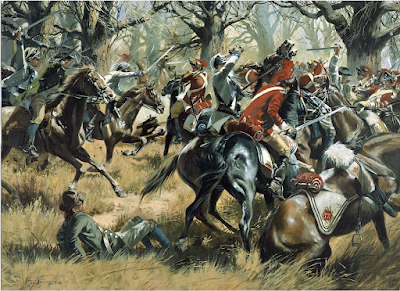After watching a recent webinar on using XDNA for genealogy (see this 2014 article for a summary, this 2012 blog from Roberta Estes, or this short YouTube video from Diahan Southard of YourDNAGuide for more information), I spent part of the weekend looking at matches on FamilyTreeDNA and Gedmatch. I had completely overlooked this type of DNA, and now see this can be a really useful addition to the toolbox for uncovering matches and inheritance patterns.
If you've transferred a DNA kit to FamilyTreeDNA and unlocked FamilyFinder (their autosomal product), you should be able to see XDNA matches. As an example, below is a partial screenshot (removing any identifying information) from FamilyFinder on my Mom's kit. I've switched to Table View, and clicked twice on the X Match column to pull all the XDNA matches to the top.
 |
| FTDNA Table View with X Matches. |
The Shared DNA column is showing autosomal DNA in centimorgans. There are other columns further on the right showing mtDNA haplogroups (if a test has been taken), and actions allowing filtering by matches In Common or Not in Common, a link to a family tree (if available) and a notes box. Several of these matches also have profiles on Ancestry or MyHeritage, so this helps identify other connections. I am currently looking at this as another angle on my Vasquez and Amado research questions.
On Gedmatch, this feature has been there for a long time but I didn't know to look for it. Select the kit you want to run a one-to-many DNA comparison on from the drop-down menu (or enter a kit number), and select filter by X DNA. I typically adjust the size to return more matches (perhaps 250), and then I leave everything else as is on the menu and hit the submit button.
 |
| Filtering by X DNA matches on Gedmatch. |
The first column shows a match number, and a kit number, with the user name and a partially anonymized email address associated with the kit. My image below cuts off those earlier columns to preserve privacy details for the matches from my Mom's kit.
 |
| Filtering by X DNA report on Gedmatch. |
Again, this is really useful, and it shows most of the largest XDNA matches share no autosomal DNA. I have to scroll down to #10 on the list to see my Mom's 2nd cousin, CD, who I know descends from my 2nd-great-grandparents Vicente Campuzano and Maria Jesus Vasquez through their daughter Concepcion Campuzano. CD has 34.6 cM XDNA in common with my Mom and 211 cM autosomal (209 on Ancestry). It's unclear if she inherited an even 50% from Vicente and Maria Jesus, but I know this 34.6 in common is coming from the Mexican side of the tree as CD won't have any XDNA in common with my Mom's paternal side.
Vicente inherited his XDNA from his mother, Maria Concepcion Amado, so some trace of her XDNA may have passed down to CD through Vicente, but more likely the part in common is from the Vasquez-Suastegui branches of the tree. I still have more to learn about XDNA inheritance and its uses for genealogy. It's great to know these tools are available and I will definitely be using this more in my DNA research questions on the Mexican side of the tree.










